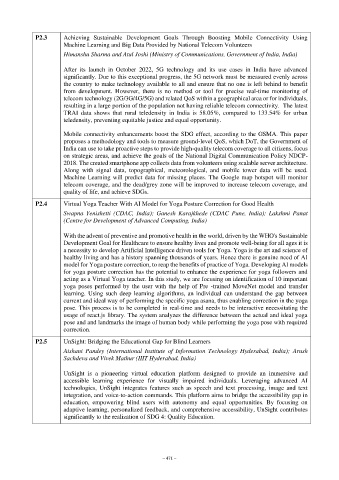Page 515 - Kaleidoscope Academic Conference Proceedings 2024
P. 515
P2.3 Achieving Sustainable Development Goals Through Boosting Mobile Connectivity Using
Machine Learning and Big Data Provided by National Telecom Volunteers
Himanshu Sharma and Atul Joshi (Ministry of Communications, Government of India, India)
After its launch in October 2022, 5G technology and its use cases in India have advanced
significantly. Due to this exceptional progress, the 5G network must be measured evenly across
the country to make technology available to all and ensure that no one is left behind to benefit
from development. However, there is no method or tool for precise real-time monitoring of
telecom technology (2G/3G/4G/5G) and related QoS within a geographical area or for individuals,
resulting in a large portion of the population not having reliable telecom connectivity. The latest
TRAI data shows that rural teledensity in India is 58.05%, compared to 133.54% for urban
teledensity, preventing equitable justice and equal opportunity.
Mobile connectivity enhancements boost the SDG effect, according to the GSMA. This paper
proposes a methodology and tools to measure ground-level QoS, which DoT, the Government of
India can use to take proactive steps to provide high-quality telecom coverage to all citizens, focus
on strategic areas, and achieve the goals of the National Digital Communication Policy NDCP-
2018. The created smartphone app collects data from volunteers using scalable server architecture.
Along with signal data, topographical, meteorological, and mobile tower data will be used.
Machine Learning will predict data for missing places. The Google map hotspot will monitor
telecom coverage, and the dead/grey zone will be improved to increase telecom coverage, and
quality of life, and achieve SDGs.
P2.4 Virtual Yoga Teacher With AI Model for Yoga Posture Correction for Good Health
Swapna Yenishetti (CDAC, India); Ganesh Karajkhede (CDAC Pune, India); Lakshmi Panat
(Centre for Development of Advanced Computing, India)
With the advent of preventive and promotive health in the world, driven by the WHO's Sustainable
Development Goal for Healthcare to ensure healthy lives and promote well-being for all ages it is
a necessity to develop Artificial Intelligence driven tools for Yoga. Yoga is the art and science of
healthy living and has a history spanning thousands of years. Hence there is genuine need of AI
model for Yoga posture correction, to reap the benefits of practice of Yoga. Developing AI models
for yoga posture correction has the potential to enhance the experience for yoga followers and
acting as a Virtual Yoga teacher. In this study, we are focusing on identification of 10 important
yoga poses performed by the user with the help of Pre -trained MoveNet model and transfer
learning. Using such deep learning algorithms, an individual can understand the gap between
current and ideal way of performing the specific yoga asana, thus enabling correction in the yoga
pose. This process is to be completed in real-time and needs to be interactive necessitating the
usage of react.js library. The system analyzes the difference between the actual and ideal yoga
pose and and landmarks the image of human body while performing the yoga pose with required
correction.
P2.5 UnSight: Bridging the Educational Gap for Blind Learners
Aishani Pandey (International Institute of Information Technology Hyderabad, India); Arush
Sachdeva and Vivek Mathur (IIIT Hyderabad, India)
UnSight is a pioneering virtual education platform designed to provide an immersive and
accessible learning experience for visually impaired individuals. Leveraging advanced AI
technologies, UnSight integrates features such as speech and text processing, image and text
integration, and voice-to-action commands. This platform aims to bridge the accessibility gap in
education, empowering blind users with autonomy and equal opportunities. By focusing on
adaptive learning, personalized feedback, and comprehensive accessibility, UnSight contributes
significantly to the realization of SDG 4: Quality Education.
– 471 –

